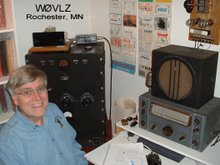Last week I traded some of my 1930s heavy metal for a Drake 2-NT novice
transmitter. At this point I'm interested in a decent rig I can carry
rather than heavy weight shelf queens that need the next door teenager
to get them out of the basement. What a great trade!
The 2-NT was introduced in 1966, late in the classic novice era when
novices were still limited to 75 watts CW only and transmitters had to
be crystal controlled. Around 2500 were produced. Within the novice
restrictions the 2-NT had features that put it far above the
competition. It was comparatively compact, included QSK or semi-breakin
transmit/receiver switching and had receiver muting. Also, 80 through 10
meter coverage made it attractive beyond the novice license. The keying
is set up so that the oscillator runs with a settable delay
and the buffer stage is keyed to minimize chirp. Drake did a fine job
with this rig.
The 2-NT was introduced with the Drake 2C but the 2-NT works well with a
lot of radios that have a built-in mute function. The receiver mute
function just needs to be designed so that the receiver mute terminal is
grounded for receive and left floating for transmit. This includes the
Drake 2B, the 4 line (R4, R4B, R4C) receivers and the SPR-4 receiver. WARNING: Drake did
this by wiring the mute function into the AVC circuit. Some radios may
do this by controlling the receiver B+. I'd be careful running receiver B+ into my
2-NT.
Now I needed to decide which receiver to pair with the 2-NT. While a
2C would be nice and would cosmetically and market wise match the 2-NT, I don't have one. I do have a 2B, an R4B and an SPR-4. The 2B is a nice radio but it is of the previous generation. For now I'll leave it paired with my Eico 720. The SPR-4 is the same design
vintage as the 2-NT and was Drake's first all transistor receiver. It is a fine example of what can be done with transistors in the mid 60s. Unfortunately Drake designed the SPR-4 as a high end SWL receiver. They didn't give me enough knobs to play with. AVC, bandwidth and passband are all fixed depending on the mode (USB/LSB/CW/AM) selected. Unfortunately the CW passband (and, therefore, the peaked CW pitch) is fixed at a higher pitch than my ears like. The SPR-4 went back on the shelf, possibly to wait for this winter and VLF experimenting. The R4B has adjustable bandwidth and passband along with AVC choices and it is of the right vintage. Like Goldilocks I found my third choice, the R4B, to be just right.
Together the 2-NT and R4B work great. I'll certainly have them on the air a lot.
The 2-NT is also featured in the Sept 2019 issue of QST, Classic Radio column.



